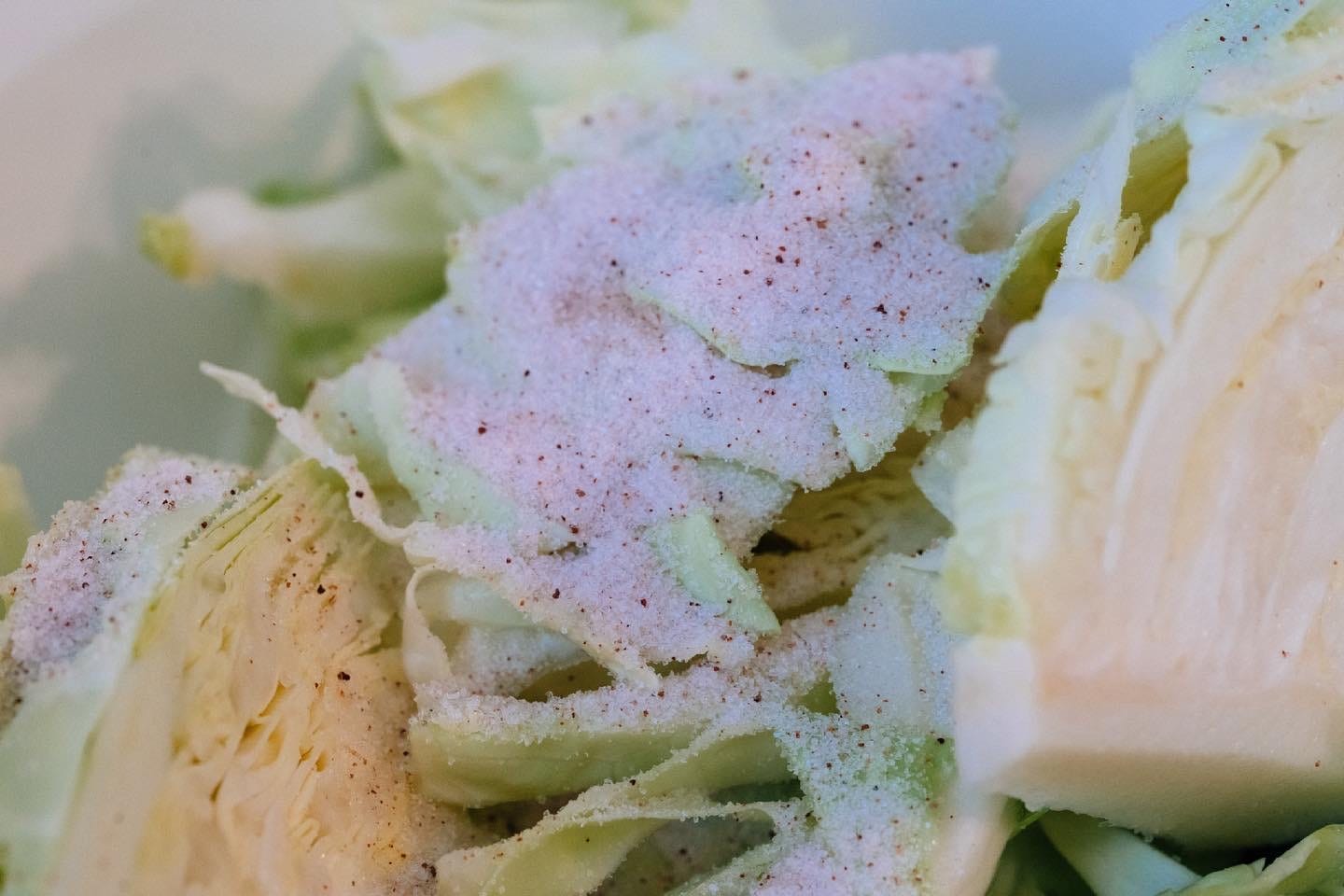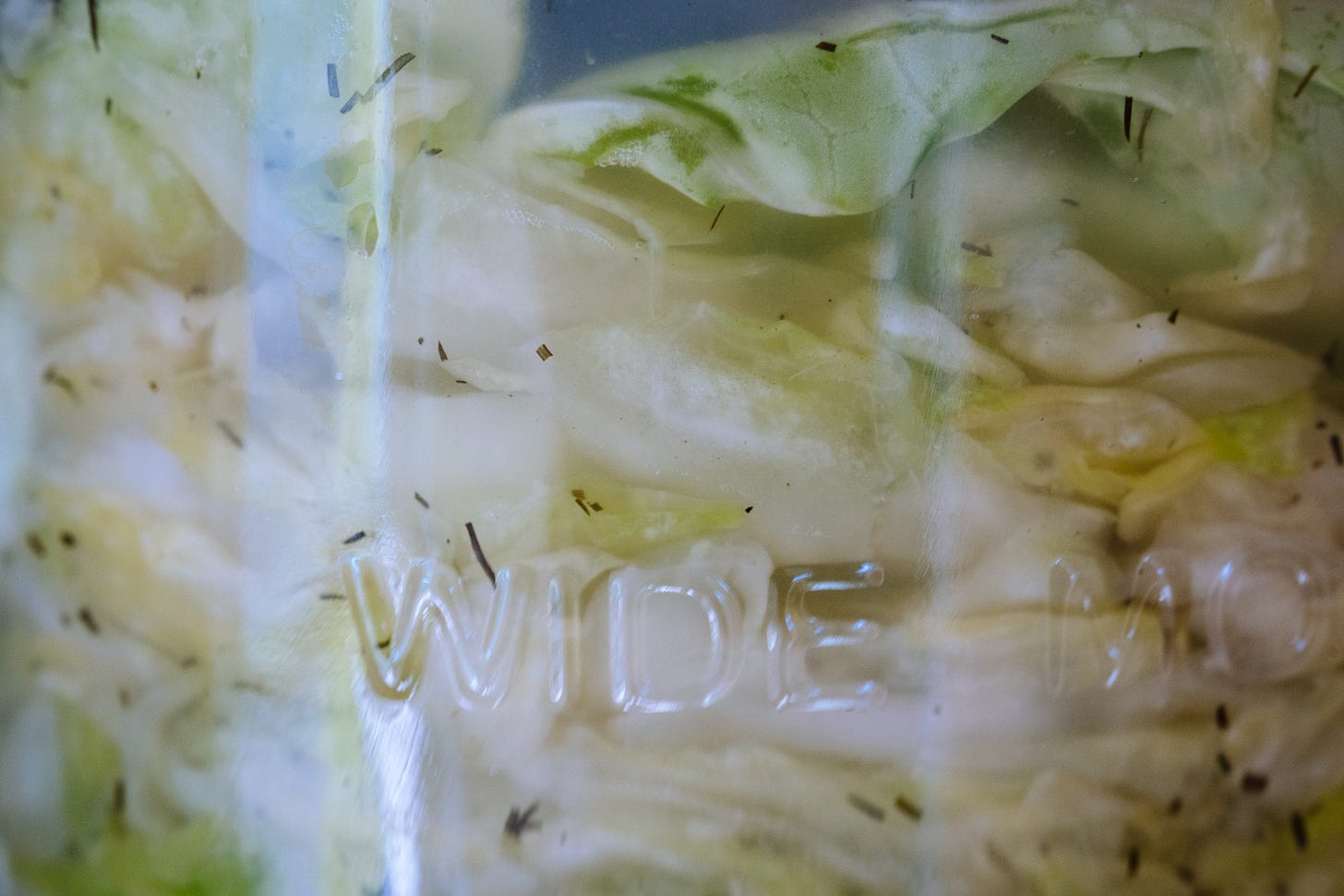Your First Ferment: Classic Sauerkraut in a Jar
Autumn
A Simple Guide to Making Sauerkraut at Home
Start your fermentation journey with something simple, ancient, and deeply satisfying: a jar of kraut made from just cabbage and salt.
The first time I made sauerkraut, I was struck by the simplicity of it all, and how much better it tasted than the expensive varieties from the store. Not only was the flavor cleaner, but in making it from scratch, I found a sense connection to the season, to the food, and to the long lineage of people who preserved food in this way before me.
If you’re new to fermented foods, sauerkraut is a beautiful place to begin. It’s affordable, adaptable, and requires no special tools, just a little time and a willingness to trust the process.

Choosing Your Cabbage
Start with a fresh, firm head of green cabbage, ideally harvested in season. Cabbages in season tend to be especially sweet and full of moisture, which makes for a plentiful brine and a better ferment.
Look for:
- Tight, heavy heads with crisp, unblemished outer leaves
- Whole cabbages, not the pre-shredded, bagged variety
- Local or organic when possible
Cabbage holds water, memory, and earth. The better your starting ingredient, the more flavor and vitality you’ll draw out through fermentation, and the easier it will be to submerge the leaves in the brine.
Step-by-Step Instructions
1. Wash your tools: Clean your jar, knife, cutting board, and mixing bowl or pot with hot, soapy water.
2. Prep the cabbage: Remove a clean outer cabbage leaf and set it aside. You’ll use this later. Rinse the cabbage and chop it finely.
3. Weigh your cabbage: Use a kitchen scale to weigh the chopped cabbage.
4. Calculate salt: Use 2% salt by weight.
Example: 1000g cabbage × 0.02 = 20g salt.
5. Salt the cabbage: Add the salt and massage it into the cabbage with clean hands for a few minutes.
6. Let it rest: Set the salted cabbage aside for 30 minutes to draw out liquid.
7. Pack the jar: Add the cabbage (and all the brine) to a clean canning jar. Make sure there is some space at the top of your jar.
8. Add the follower leaf: Press the reserved leaf on top to keep chopped cabbage submerged.
9. Weigh it down: Add a fermentation weight or a zip-top bag filled with water to keep everything submerged.
10. Seal the jar: Use an airlock lid if you have one. If you’re using the water-filled bag, it also acts as a seal.
11. Let it ferment: Set the jar on your counter (out of direct sunlight) and let it ferment at room temperature for at least 3 days.
Ingredients & Equipment
- 1 head of cabbage
- Salt (non-iodized, like sea salt or kosher salt)
- A quart or half-gallon glass jar
- Knife + cutting board
- Mixing bowl or pot
- Kitchen scale
- Fermentation weight or water-filled zip-top bag
- Airlock lid (optional, but helpful)
What to Expect During Fermentation
- Color change: The cabbage will lose its bright green color and turn pale yellow.
- Bubbles and cloudiness: These are signs of healthy fermentation!
- Smell: Expect a pleasantly sour, tangy aroma.
Make sure your cabbage stays submerged in brine at all times as this prevents mold. If it starts to float, press it back down.
After 3 days, begin tasting your kraut. If it’s not tangy enough, let it go another few days, tasting daily until it’s just right. I usually ferment mine for 5–7 days, depending on the season.
Note:Fermentation happens faster in warm weather and slower when it’s cool.
Troubleshooting Tips
Mold & Kahm Yeast
- Use clean tools and hands to reduce contamination.
- White scum is usually harmless, often just kahm yeast, which is safe (it just looks strange).
- Green or black fuzzy growth is mold. If your kraut is moldy, it’s best to throw it out. I’ve only had my kraut develop mold a couple of times, and both times I had added lemon juice to the ferment, so I recommend avoiding lemon juice as a flavoring.
Mushy Kraut
- Can be caused by fermenting too long, too hot, or with the wrong salt ratio.
- Aim for cooler spots in your home (60–70°F is ideal).
- Always weigh ingredients and use a 2–3% salt ratio by weight for best results.
Optional Flavor Additions
- Caraway seeds: Traditional and aromatic. Add up to a half tsp. These are pungent so use sparingly
- Carrots: Grated carrots add sweetness and color.
- Garlic: Add sliced or whole cloves. Note: garlic may turn blue or purple during fermentation which is completely safe.








